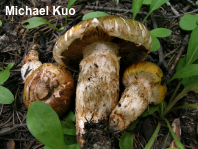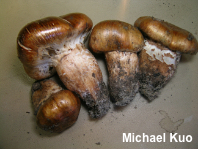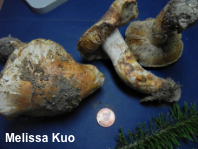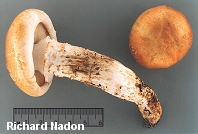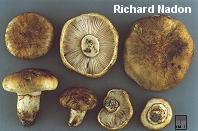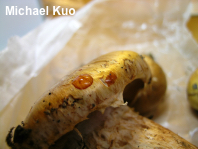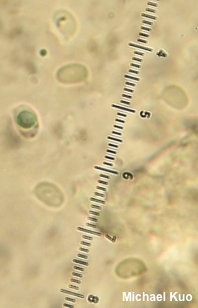| Major Groups > Gilled Mushrooms > Pale-Spored > Tricholoma > Tricholoma focale |

|
Tricholoma focale [ Basidiomycota > Agaricales > Tricholomataceae > Tricholoma . . . ] by Michael Kuo Found under pines across northern and montane North America, Tricholoma focale is fairly easily identified on the basis of its orange-brown colors, its collapsing cottony ring, and its strong mealy odor. With maturity, olive shades may begin to develop on the cap. A drop of KOH on the cap surface produces a bright dull to bright red reaction. Microscopic features for Tricholoma focale are fairly boring, but include an ixocutis and relatively small spores. Although an in-depth contemporary study of Tricholoma focale has not been done, collections from California, Sweden, and Denmark were grouped together in an ITS-based DNA survey of the genus (Heilmann-Clausen and collaborators 2017), suggesting a transcontinental distribution. Armillaria zelleri and Tricholoma zelleri are synonyms, according to most mycologists. Armillaria zelleri was named by Stuntz and Smith (in Smith, 1949), who argued that its sticky cap distinguished it from Armillaria focalis, which had a dry cap. However, while the original description (Fries, 1838) of Armillaria focalis did not mention whether the cap was sticky or dry, contemporary European concepts of the species (now known as Tricholoma focale) require a sticky cap—which removes the stated justification for Armillaria zelleri as a distinct species. Several North American authors (Ovrebo, 1980; Shanks, 1994, 1997) have therefore reduced Armillaria zelleri to synonymy with Tricholoma focale. Description: Ecology: Mycorrhizal with conifers—especially pines; growing alone, scattered, or gregariously; fall or, in warmer climates, over winter; fairly widely distributed in northern and montane North America. The illustrated and described collections are from Colorado and Québec. Cap: 4–8 cm; convex, becoming broadly convex to nearly flat when mature; sticky at first, but soon dry and shiny; covered with long, innate fibrils; orangish golden to orange-brown, often developing brown to olive hues; the margin at first inrolled and adorned with white veil tissue. Gills: Attached to the stem by a notch; close; short-gills frequent; whitish; discoloring and spotting brownish to brown with age. Stem: 5–9 cm long; 2–3 cm thick; more or less equal above a tapered base; with a cottony white ring that discolors brownish and often collapses with age; bald and whitish above the ring but shaggy below it, with orange-brown fibrils over a buff ground color. Flesh: Whitish or slightly brownish in places; unchanging when sliced. Odor and Taste: Odor strongly mealy; taste mealy, often with a foul or bitter component. Chemical Reactions: KOH on cap surface dull to bright red. Spore Print: White. Microscopic Features: Spores 4–6 x 2.5–3.5 µm; ellipsoid; smooth; inamyloid; hyaline in KOH. Basidia 4-sterigmate. Pleurocystidia not found. Cheilocystidia not found. Lamellar trama parallel. Pileipellis an ixocutis of cylindric elements 2.5–5 µ wide, smooth, orangish brown in KOH. Clamp connections not found. REFERENCES: (Fries, 1838) Ricken, 1915. (Saccardo, 1887; Kauffman, 1918; Smith, 1949; Ovrebo, 1973; Ovrebo & Tylutki, 1975; Thiers & Sundberg, 1976; Smith, Smith & Weber, 1979; Ovrebo, 1980; Arora, 1986; Phillips, 1991/2005; Lincoff, 1992; Shanks, 1994; Evenson, 1997; Barron, 1999; Noordeloos & Christensen, 1999; McNeil, 2006; Miller & Miller, 2006; Christensen & Heilman-Clausen, 2008; Trudell & Ammirati, 2009; Bessette et al., 2013; Christensen & Heilmann-Clausen, 2013; Desjardin, Wood & Stevens, 2015; Evenson, 2015; Siegel & Schwarz, 2016; Cripps, Evenson & Kuo. 2016; Heilmann-Clausen et al. 2017.) Herb. Kuo: 08081005. Herb. DBG: RMNP 2008-169, RMNP 2008-179, RMNP 2008-188, ROMO 2012 5026-11. This site contains no information about the edibility or toxicity of mushrooms. |
© MushroomExpert.Com |
|
Cite this page as: Kuo, M. (2018, November). Tricholoma focale. Retrieved from the MushroomExpert.Com Web site: http://www.mushroomexpert.com/tricholoma_focale.html |
